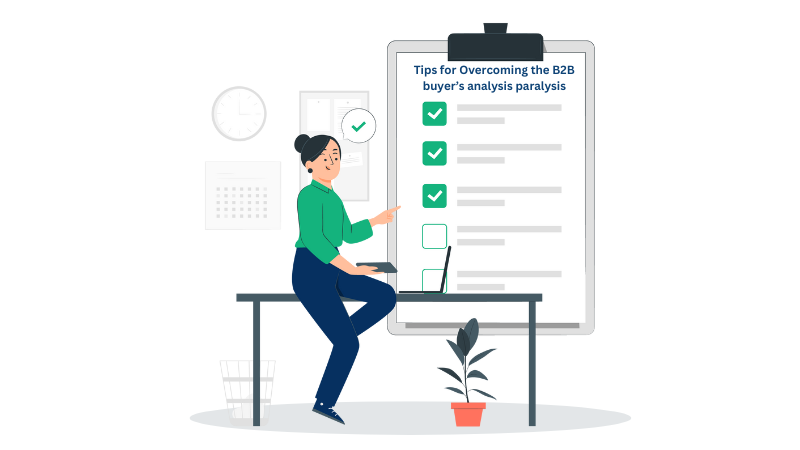Have you ever felt overwhelmed by too many options and ended up frustrated because picking one was tough?
From picking a candy bar to choosing the right pair of shoes to wear for work, for sure everyone has been there. An overabundance of choices can outweigh a position and cause “paralysis,” where one is unable to reach a solution, an action, or a conclusion.
Martin Cothran, a famous writer, calls this Cheesecake Factory Syndrome.“In case you didn’t know, the Cheesecake Factory has a menu the size of Harry Potter and the Order of the Phoenix. There are so many options that you feel depressed afterward thinking about all the things you could have had but didn’t because you could order only one thing out of so many.”
B2B business owners and consumers now enjoy the digital era where massive amounts of information are readily available through computer technology and the Internet. Technological advancements improve how businesses serve customers through the likes of Robotic Process Automation and Artificial Intelligence. The process of moving businesses into the digital age and using technological tools to upgrade your organization is called digitization.
Part of digitization is the usage of search engines like Google. People now find it easier to find the information they need online. With millions of websites to browse from and a vast collection of knowledge that can readily be accessed whenever a question pops into mind, the vast number of options allows everyone to choose how to digest the information they’re given.
Although B2B buyers find first-rate data helpful in decision-making, it doesn’t make the process easier. Psychologist Barry Schwartz describes this phenomenon as the paradox of choice. Based on his findings, he states that while the provision of many options allows reaching better results, it also leads to higher levels of indecision, dissatisfaction, paralysis, and anxiety. The paradox of choice contends that having too many options restricts freedom.
Related: How to Launch a Lead Generation Campaign
This circumstance of indecisiveness, when taken into the B2B context, is called the B2B Buying Analysis Paralysis.
Indecision is a common challenge in B2B sales. A “no decision” is often more frustrating than losing to a competitor.
A study found that 40% to 60% of B2B deals end in no decision, which means a significant loss of potential revenue. So, why does this happen?
The main issue is fear of making the wrong choice. Buyers often freeze, not because they’re satisfied with their current solution, but because they worry about choosing poorly. It’s not about missing a better option; it’s about avoiding the risk of error.
Now, let’s discuss the three dimensions of buying analysis paralysis.
The three dimensions of buying analysis paralysis

Information overload is undeniably overwhelming, and B2B marketers aren’t strangers to this. Whether from B2B lead generation, reaching out to target audiences, or finding the right marketing strategies of close competitors, it’s difficult to make a choice. Read on to learn more about the three dimensions of buying analysis paralysis.
- Horizontal – the buyer has a difficulty in choosing several or two similar offers
- Vertical – here, the buyer finds it difficult to estimate a product or service
- Internal – this entails the desire to select the best option combined with the fear of failing to do so.
Buyers, in most instances, suffer a combination of these three; and the situation is much more difficult in B2B since products and services are harder to analyze. Furthermore, their choices have an impact on the decision-maker’s relationships with top management, coworkers, social standing, image, and profession.
In turn, those who suffer from buying analysis paralysis halt their deals and company growth. To discuss this problem, there’s a need to understand these 4 psychological factors that make decision-making hard for buyers: decision paralysis, status quo bias, the impact of early influence, and loss aversion.
- Decision paralysis – the more attractive the other options are, the less likely they are to buy a product or avail of a service.
- Status quo bias – change is scary, which might be the reason why most people prefer to stay where they are most comfortable. When change comes, they tend to see it as a loss. This tendency is called the status quo bias.
Although the status quo bias often makes people hesitant to change, it can also have a significant impact on their choices. - The impact of early influence – Budget, Authority, Need, and Time Frame, or BANT, was once a common method for evaluating sales opportunities. Salespeople are encouraged to rule out early opportunities that aren’t yet official projects.
- Loss aversion – this is a phenomenon wherein the losses are weighted more than the gains.
LinkedIn defines it as the pain someone feels over losing something they already own, which is twice as powerful as the pleasure they feel over gaining something extra.
The causes and symptoms of B2B buying analysis paralysis

Psychologists claim that there are many reasons why B2B marketers (or basically anyone) are ailed by analysis paralysis. Among these are:
- The fear of making the wrong decision
- The obsession with achieving perfect outcomes, and delaying their decisions in turn
- The buyer may be overwhelmed with too many options and find it difficult to choose one resolution
- The customer tends to over-complicate things
What are the tell-tale signs that a buyer is experiencing analysis paralysis? As a seller, here’s what you should look out for:
- The customer has a history of delaying or failing to complete what appears to be a “no-brainer” purchase decision.
- The customer frequently expresses strong regret for previous bad decisions, such as “this should not have happened.”
- You have proof that the company continues to throw good money after bad rather than admitting and moving on from previous purchasing mistakes.
- The customer has a history of delaying or failing to complete what appears to be a “no-brainer” purchase decision.
Effects of buyer’s analysis paralysis (and the role of anxiety)
B2B companies nowadays are directly affected by buyer analysis in terms of lead generation. Researching up front to target the right prospects is a must, but distraction and information overload hinder companies from reaching their target audience.
Here are several ways that overthinking and anxiety hold back companies from achieving their goals.
- Overthinking saps your willpower.
Overanalyzing can wear you out and reduce your willpower. Daily tasks like light household chores, eating, and grooming usually require little energy. When you’ve been overthinking frequently, you may develop decision fatigue, which makes making easy decisions a tedious task. - Overthinking reduces your ability to perform mentally demanding tasks.
Prolonged exposure to high-stress levels and fast-paced work types are certified performance killers. When you try to push your brain beyond its capacity, your performance suffers. Your brain can only handle and process so much information at once.
Overanalyzing and overthinking things results in worry, tension, and anxiety, which reduces your capacity to do other tasks, such as being creative and productive. Overthinking can result in self-doubt too. - It dampens creativity
Thinking processes and executive functioning are centered in the prefrontal cortex. This is the same area where creativity lies. Exerting a lot of your resources on analyzing and thinking leaves little space for creativity. - It makes you unhappy
Overthinking might prevent you from having pleasant ideas and put your mind in a perpetually pessimistic state of mind since it tends to dwell on the negative. Your mental well-being and productivity suffer when your level of happiness declines. This can impact the choices you make, your capacity for addressing problems, and your interpersonal relationships at work.
Tips to overcome the B2B Buying Analysis Paralysis
Listed below are some techniques to assist you in moving forward, taking action, and making better judgments if you find yourself entangled in the snares of buying analysis paralysis.
- Narrow down your options as soon as possible
If you have a vast number of options, it’s better to cross out some right away. Eliminate any choices that don’t meet the criteria for the result you want to achieve. You can do this by deciding what your desired outcome is before making a choice. - Set a deadline for decision-making
Not having a timeline for decision-making will have you shuffling back and forth between options, which is an ultimate waste of time. If you want to be more productive and want to get over it already, try setting a deadline or a specific time frame for the decision to be made. - Make decisions using a framework
The decision-making process entails gathering information, evaluating alternatives, and ultimately making a final decision. You can follow this step-by-step guide to help lessen the mental work that’s needed for making big decisions. - Make rapid decisions a habit.
Impulsivity can cause trouble, but it’s not always a bad thing. Here’s a tip: Practice making quick, simple decisions if analysis paralysis plagues you all the time. Small decisions like deciding what and where to eat lunch will help you become more decisive when you’re put in a situation where you should make a big choice.
Partner with the expert marketing agency that excels in selling your product. Close deals faster without the analysis paralysis.
Overcoming the B2B buyer’s analysis paralysis

Analysis paralysis is a looming yet unacknowledged problem that continues to frustrate sellers. The good thing about it is that it’s solvable. Take a look at these six tips sellers can follow to overcome this:
- Kindly remind buyers that deciding not to make a decision is a decision itself.
- Specify no more than three reliable options for your customers. Over three options raise the risk that a consumer won’t make a purchase.
- Create a decision-inducing deadline to eliminate the possibility of procrastination. For example, “Our special offer expires at the end of November.”
- Assist buyers in quantifying the expenses they are avoiding.
- Ask buyers to visualize how they will feel if a proactive step they are thinking about today pays off but they do not take the chance.
- Ask your customers what they would do if they were thinking about this choice without taking previous choices into account.
B2B buyer analysis FAQs
- How does analysis paralysis affect consumer decisions?
The phrases “analysis paralysis” and “decision paralysis” are usually used interchangeably. Consumer behavior specialists realized that having fewer options yields superior results compared to overwhelming the public with limitless options. - What is analysis paralysis’ opposite?
While analysis paralysis refers to the condition in which a person is unable to decide because they become mired in trying to weigh all of their options, there’s one thing that’s the exact opposite: “utopia myopia”.
Every time a choice needs to be made, there’ll always be a small group of people or an individual who are adamant about what should be built and why, and who will not back down from their position or agree that further information or investigation is required. A careless disregard for facts is a defining feature of this condition.
This is a situation where someone decides without research, analysis, or little to no debate at all. This person believes this is the only option, or perhaps even the best one. - What is the root cause of analysis paralysis?
It all boils down to anxiety. Decision-making itself is difficult enough. What if you make the wrong one? This mindset nurtures analysis paralysis. It’s because the human brain is wired to make the best decision every single time even though there’s no right solution. Indecision can be a sign of impostor syndrome. When you’re more of a perfectionist, making a big decision can throttle you down into analysis paralysis.
So, how much is TOO much?

B2B buying analysis paralysis can not just cripple your customer’s decision-making process, but also impact B2B businesses. Here’s how:
Delayed decision-making: The B2B buying process is already lengthy, and buying analysis paralysis can further prolong the process. Because of indecisiveness, B2B buyers might need more time to evaluate options, delaying the final purchase decision. This can slow down the implementation of solutions, disrupting project timelines and overall business operations.
Change in priorities: Analysis paralysis may make buyers shift their priorities and criteria. As a result, B2B companies may need to adjust their strategies in how they develop products, market, and handle sales to meet their customers’ evolving needs.
Challenges in resource allocation: Extended decision-making periods pose challenges in effectively allocating resources for B2B companies. The allocation of budgets, staffing, and marketing efforts becomes particularly challenging when revenue generation timing is not set.
Difficulty in goal-setting due to arising uncertainty: Growing uncertainty among buyers impacts B2B companies, making it challenging to set clear goals and plan for revenue, resources, and strategy. Analysis paralysis complicates sales forecasting, requiring ongoing adjustments due to uncertainties in timing and volume of conversions.
Exposure to increased competition: Extended decision-making exposes B2B companies to more competition. When buyers take longer to decide, there are greater chances that they might come across other providers, intensifying the competition for the same potential clients.
Need for Additional Support: Buyers in analysis paralysis often need extra guidance, information, and support. This may lead to increased demands on customer support, sales teams, and educational content creation to aid in their decision-making process.
Personalize Your B2B Outreach! Ensure your products are introduced in a way that aligns with your customers' preferences.
Breakthrough B2B buying analysis paralysis with expert help
Every aspect of your business and work life involves decision-making. Most decisions require a little more deliberation, especially in the B2B industry. Overthinking a decision is a risky move especially when you’re presented with too many options to choose from. It’s as self-sabotaging as deciding randomly.
Now, you might ask: How many options are TOO much? If you are struggling with analysis paralysis, you can start by first defining your objectives. Then, narrow your options to a few that meet them. After taking a good look at the benefits and drawbacks of each option, you can now proceed to pick one.
B2B buying analysis is one of the most frustrating situations faced by today’s corporate decision-makers. Part of your job is making huge decisions, and sometimes you need to do it quickly.
So, how do you efficiently shrink your options and make sure that you choose the best one? The secret lies in working together with a trusted lead generation services provider.
Related: Top B2B Lead Gen for SaaS in Australia
Choose a reliable lead generation services provider for optimal decision-making
Lead generation service providers are crucial in helping businesses overcome analysis paralysis. Leveraging their expertise, they analyze datasets to offer leads aligning with the buyer’s profile, reducing information overload and easing decision-making.
Working with these providers offers the advantage of customized solutions, shaped through collaboration and understanding buyer preferences. Lead scoring techniques help prioritize leads, empowering buyers to focus on promising opportunities and reducing analysis paralysis.
Partnering with a trusted provider like Callbox enhances these benefits, combining expertise in data analysis, customized solutions, and effective lead scoring for efficient decision-making in the B2B landscape.
Our expertise in Account-Based Marketing (ABM) strategy becomes a crucial ally in dodging the pitfalls of B2B buying analysis paralysis. By precisely targeting and reaching potential clients, we address the challenges associated with extended decision-making periods.
Our Multi-touch Multi-channel approach helps streamline the decision-making process for B2B buyers by providing information through various channels, reducing information overload, and facilitating more confident and efficient decision-making.
In the pursuit of optimal decision-making, choosing a reliable lead generation services provider is paramount. Partnering with Callbox can significantly impact the quality of your leads and result in an impressive ROI as you venture in Australia and APAC.
Transform your B2B outcomes with Callbox. Call us now and kickstart your path to success!













